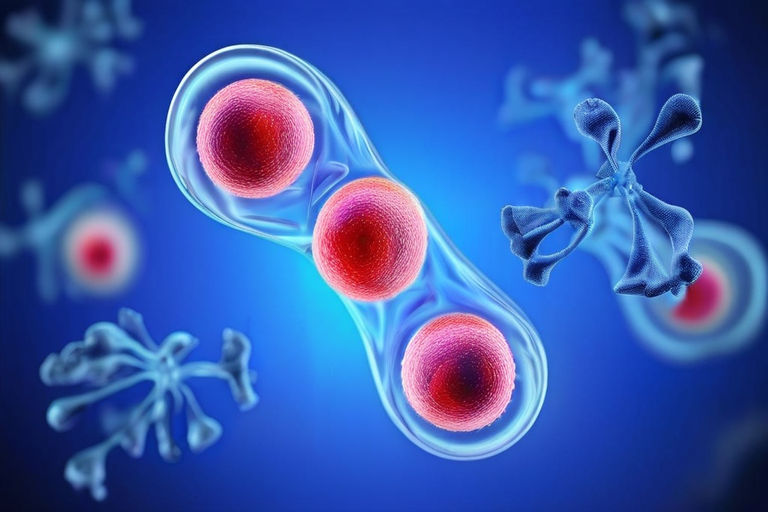Introduction
Understanding how cells divide is fundamental to grasping the concepts of biology and life itself. Cell division is a process that allows organisms to grow, repair damaged tissues, and reproduce. Two primary forms of cell division, mitosis and meiosis, play crucial roles in these processes. While mitosis is essential for growth and repair, meiosis is vital for sexual reproduction and genetic diversity. Knowing the differences between these two types of cell division helps us appreciate how life is sustained and evolved. Let’s delve into the fascinating world of mitosis and meiosis to better understand their significance and distinct characteristics.
Understanding Cell Division
Definition of Cell Division
Cell division is the process by which a single cell divides into two or more daughter cells. This is a crucial mechanism in all living organisms, ensuring that cells can replicate and multiply. There are two main types of cell division in eukaryotic cells: mitosis and meiosis.
The Role of Cell Division in Growth and Reproduction
Cell division plays a pivotal role in both growth and reproduction. In terms of growth, cell division allows organisms to increase in size by producing more cells. It is also essential for repairing and replacing damaged or dead cells, maintaining the health and functionality of tissues and organs.
In terms of reproduction, cell division is fundamental. Mitosis enables asexual reproduction, where an organism can reproduce without the need for a mate, producing offspring that are genetic clones of the parent. Meiosis, on the other hand, is vital for sexual reproduction, producing gametes (sperm and eggs) that carry half the genetic information of the parent. This ensures that when two gametes fuse during fertilization, the resulting offspring have a complete set of chromosomes, inheriting genetic material from both parents.
What is Mitosis?
Definition of Mitosis
Mitosis is a type of cell division where a single cell divides to produce two genetically identical daughter cells, each containing the same number of chromosomes as the parent cell. This process ensures that each new cell receives an exact copy of the parent cell’s DNA.
Purpose of Mitosis in Organisms
Mitosis serves several critical functions in living organisms:
- Growth: Mitosis is responsible for the growth of an organism from a single fertilized egg to a complex multicellular entity. By producing more cells, mitosis allows the organism to increase in size and develop specialized tissues and organs.
- Repair and Maintenance: Mitosis plays a key role in repairing and replacing damaged or dead cells. For instance, when you get a cut on your skin, mitosis helps produce new skin cells to heal the wound.
- Asexual Reproduction: In certain organisms, such as many plants, fungi, and single-celled organisms, mitosis is the primary method of asexual reproduction. This process enables these organisms to reproduce quickly and efficiently, producing offspring that are genetic clones of the parent.
Stages of Mitosis
Mitosis is a complex process that can be broken down into several distinct stages, each crucial for ensuring the accurate division of chromosomes. These stages are prophase, metaphase, anaphase, telophase, and cytokinesis.
Prophase
During prophase, the chromatin (a mix of DNA and proteins) condenses into visible chromosomes. Each chromosome has already been replicated and consists of two sister chromatids joined at the centromere. The nuclear membrane begins to disintegrate, and the mitotic spindle, a structure made of microtubules, starts to form from the centrosomes.
Metaphase
In metaphase, the chromosomes align at the cell’s equatorial plane, known as the metaphase plate. The spindle fibers attach to the centromeres of the chromosomes, ensuring that each sister chromatid is connected to a spindle fiber from opposite poles of the cell. This alignment ensures that each daughter cell will receive one copy of each chromosome.
Anaphase
Anaphase is characterized by the separation of the sister chromatids. The spindle fibers shorten, pulling the sister chromatids apart and toward opposite poles of the cell. This movement ensures that each new daughter cell will have an identical set of chromosomes.
Telophase
During telophase, the chromosomes reach the opposite poles of the cell. The spindle fibers disassemble, and a new nuclear membrane forms around each set of chromosomes, creating two distinct nuclei. The chromosomes begin to de-condense back into chromatin, preparing for the eventual division of the cytoplasm.
Cytokinesis
Cytokinesis is the final stage of cell division, where the cytoplasm divides to form two separate daughter cells. In animal cells, this process involves the formation of a cleavage furrow that pinches the cell into two. In plant cells, a cell plate forms along the equator of the cell, eventually developing into a new cell wall that separates the two daughter cells.
Through these stages, mitosis ensures that each daughter cell receives an identical set of chromosomes, maintaining the genetic continuity essential for growth, repair, and asexual reproduction in multicellular organisms.
What is Meiosis?
Definition of Meiosis
Meiosis is a specialized form of cell division that reduces the chromosome number by half, resulting in four genetically unique daughter cells. Each daughter cell contains half the number of chromosomes of the parent cell. This reduction is essential for sexual reproduction and occurs only in germ cells, which are cells destined to become gametes (sperm and eggs).
Purpose of Meiosis in Organisms
Meiosis serves several critical functions in living organisms:
- Production of Gametes: The primary purpose of meiosis is to produce gametes for sexual reproduction. In animals, this means producing sperm and egg cells, each containing half the number of chromosomes of the parent cell. This reduction is necessary so that when fertilization occurs, the resulting zygote has the correct number of chromosomes.
- Genetic Diversity: Meiosis introduces genetic variation through two key mechanisms: crossing over and independent assortment. During crossing over, homologous chromosomes exchange segments of DNA, creating new combinations of genes. Independent assortment refers to the random distribution of homologous chromosome pairs into daughter cells. These processes ensure that each gamete is genetically unique, contributing to the genetic diversity of offspring.
- Maintaining Chromosome Number: By reducing the chromosome number by half, meiosis ensures that the chromosome number remains constant across generations. Without this reduction, the fusion of two gametes during fertilization would result in offspring with twice the number of chromosomes, leading to potential genetic abnormalities.
Stages of Meiosis
Meiosis is a complex process that involves two successive divisions, Meiosis I and Meiosis II, each with distinct stages. Let’s explore the stages of each division:
Meiosis I
Prophase I
During prophase I, homologous chromosomes pair up and undergo synapsis, forming structures called tetrads. Crossing over occurs, where segments of DNA are exchanged between non-sister chromatids, leading to genetic recombination. The nuclear envelope breaks down, and spindle fibers begin to form.

Metaphase I
In metaphase I, the tetrads align at the cell’s equatorial plane, with each homologous pair attached to spindle fibers from opposite poles. The orientation of the tetrads is random, contributing to genetic diversity.
Anaphase I
Anaphase I is characterized by the separation of homologous chromosomes, with one chromosome from each pair pulled to opposite poles of the cell by the spindle fibers.
Telophase I
During telophase I, the separated homologous chromosomes reach the poles of the cell, and a nuclear envelope reforms around each set. Cytokinesis I, the division of the cytoplasm, occurs simultaneously, resulting in two haploid daughter cells, each containing half the number of chromosomes as the parent cell.
Meiosis II
Prophase II
In prophase II, a new spindle apparatus forms in each haploid daughter cell, and the nuclear envelope breaks down again.
Metaphase II
During metaphase II, the chromosomes align at the equator of each cell, with each sister chromatid attached to spindle fibers from opposite poles.
Anaphase II
Anaphase II is similar to anaphase in mitosis, with the sister chromatids separating and being pulled to opposite poles by the spindle fibers.
Telophase II
Telophase II marks the final stage of meiosis, where the separated chromatids reach the poles of the cells, and a nuclear envelope forms around each set. Cytokinesis II, the division of the cytoplasm, occurs, resulting in four haploid daughter cells, each containing a unique combination of genes.
Through these stages, meiosis ensures the production of genetically diverse gametes, essential for sexual reproduction and the continuation of species.
Key Differences Between Mitosis and Meiosis
Understanding the differences between mitosis and meiosis is essential as they serve distinct purposes in cellular biology and organismal reproduction. Let’s explore the key differences between these two types of cell division:
Number of Divisions
Mitosis: Mitosis involves a single division of the cell, resulting in two daughter cells that are genetically identical to the parent cell. This process ensures the growth, development, and maintenance of multicellular organisms.
Meiosis: Meiosis consists of two successive divisions, Meiosis I and Meiosis II, resulting in four daughter cells. Each daughter cell has half the number of chromosomes as the parent cell, making them haploid. Meiosis is essential for sexual reproduction, producing gametes with genetic variation.
Daughter Cells Produced
Mitosis: Mitosis produces two daughter cells, each containing the same number of chromosomes as the parent cell. These daughter cells are genetically identical to each other and the parent cell. Mitosis is involved in growth, tissue repair, and asexual reproduction.
Meiosis: Meiosis produces four daughter cells, each with half the number of chromosomes as the parent cell. These daughter cells are genetically diverse due to crossing over and independent assortment of chromosomes during meiosis I. Meiosis is crucial for sexual reproduction, ensuring genetic diversity in offspring.
Genetic Variation
Mitosis: Mitosis does not contribute to genetic variation as the daughter cells are identical to the parent cell. Any variation that occurs is due to mutations or genetic recombination in preceding generations.
Meiosis: Meiosis introduces genetic variation through two key mechanisms: crossing over and independent assortment of chromosomes. Crossing over occurs during prophase I, where homologous chromosomes exchange genetic material, creating new combinations of genes. Independent assortment occurs during metaphase I, where homologous chromosome pairs align randomly at the cell’s equator, leading to different combinations of chromosomes in the daughter cells.
Role in the Organism
Mitosis: Mitosis plays a crucial role in growth, tissue repair, and maintenance of multicellular organisms. It ensures that cells can divide and replace damaged or dead cells, allowing for the development and maintenance of tissues and organs.
Meiosis: Meiosis is essential for sexual reproduction in sexually reproducing organisms. It produces gametes with genetic diversity, ensuring that offspring inherit a unique combination of genes from their parents. Meiosis also maintains the stable chromosome number of species across generations.
Similarities Between Mitosis and Meiosis
While mitosis and meiosis are distinct processes with different outcomes, they share some similarities in their basic process of cell division and the stages involved:
Basic Process of Cell Division
Both mitosis and meiosis are forms of cell division that involve the replication and distribution of genetic material to daughter cells. They are essential for the growth, development, and reproduction of organisms.
Similar Stages
Both mitosis and meiosis involve similar stages of cell division, including:
- Prophase: Chromosomes condense, the nuclear envelope breaks down, and spindle fibers form.
- Metaphase: Chromosomes align at the cell’s equator, attached to spindle fibers from opposite poles.
- Anaphase: Sister chromatids (or homologous chromosomes in meiosis I) separate and move to opposite poles of the cell.
- Telophase: Chromosomes reach the poles, and nuclear envelopes re-form around each set of chromosomes.
- Cytokinesis: The cytoplasm divides, resulting in the formation of two daughter cells (in mitosis) or four daughter cells (in meiosis).
While the outcomes of mitosis and meiosis differ significantly, the shared stages ensure the accurate distribution of genetic material to daughter cells in both processes.
Significance of Mitosis and Meiosis
Mitosis and meiosis are essential processes in biology, each serving distinct roles in growth, repair, and reproduction, as well as contributing to genetic diversity. Let’s explore the significance of both processes:
Importance in Growth, Repair, and Reproduction
Mitosis: Mitosis plays a vital role in the growth and development of multicellular organisms. It allows for the production of new cells, which are necessary for increasing the size of an organism and replacing damaged or dead cells. Mitosis is crucial for tissue repair and regeneration, ensuring that wounds heal and tissues remain functional.
Meiosis: Meiosis is essential for sexual reproduction in sexually reproducing organisms. It produces gametes (sperm and eggs) with half the number of chromosomes as the parent cell, ensuring that when fertilization occurs, the resulting zygote has the correct chromosome number. Meiosis also allows for the shuffling of genetic material through crossing over and independent assortment, contributing to genetic diversity in offspring.
Role in Genetic Diversity
Mitosis: Mitosis does not directly contribute to genetic diversity, as the daughter cells produced are genetically identical to the parent cell. However, mutations can occur during DNA replication or cell division, leading to genetic variation in subsequent generations.
Meiosis: Meiosis is crucial for generating genetic diversity in sexually reproducing organisms. Crossing over, which occurs during prophase I, results in the exchange of genetic material between homologous chromosomes, creating new combinations of genes. Additionally, independent assortment, which occurs during metaphase I, leads to different combinations of chromosomes in the daughter cells. These processes ensure that each gamete produced through meiosis is genetically unique, contributing to the genetic variation observed within populations.
Conclusion
In conclusion, mitosis and meiosis are fundamental processes in cellular biology, each with its own unique role and significance. Mitosis is responsible for growth, repair, and maintenance of multicellular organisms, ensuring the production of new cells that are genetically identical to the parent cell. On the other hand, meiosis is essential for sexual reproduction, producing genetically diverse gametes that contribute to genetic variation in offspring.
Throughout this discussion, we’ve highlighted several key points:
- Mitosis involves a single division of the cell, producing two daughter cells with the same number of chromosomes as the parent cell, while meiosis consists of two divisions, resulting in four daughter cells with half the number of chromosomes.
- Mitosis plays a crucial role in growth, repair, and asexual reproduction, while meiosis is vital for sexual reproduction and genetic diversity.
- Mitosis and meiosis share similarities in their basic process of cell division and some stages, but they serve distinct purposes and have different outcomes.
- Understanding mitosis and meiosis is essential for comprehending how organisms grow, develop, and reproduce, as well as for understanding genetic variation and evolution within populations.
In essence, a thorough understanding of mitosis and meiosis is essential for anyone studying biology or interested in the mechanisms underlying growth, reproduction, and genetic diversity in living organisms. By grasping the intricacies of these processes, we gain deeper insights into the complexities of life itself.
FAQs
1. What happens if mitosis goes wrong?
If mitosis goes wrong, it can lead to various abnormalities and diseases. Errors in mitosis can result in genetic mutations, chromosomal abnormalities, and cell division defects. These abnormalities may manifest as cancer, developmental disorders, or other genetic diseases.
2. Why is meiosis important for sexual reproduction?
Meiosis is essential for sexual reproduction because it reduces the chromosome number by half, ensuring that when gametes fuse during fertilization, the resulting zygote has the correct chromosome number. Meiosis also introduces genetic variation through processes like crossing over and independent assortment, contributing to genetic diversity in offspring.
3. Can meiosis occur in somatic cells?
No, meiosis cannot occur in somatic cells. Meiosis is a specialized form of cell division that occurs only in germ cells, which are cells destined to become gametes (sperm and eggs). Somatic cells, which make up the majority of an organism’s body, undergo mitosis for growth, repair, and maintenance.
4. How do mitosis and meiosis contribute to genetic variation?
Mitosis does not directly contribute to genetic variation, as the daughter cells produced are genetically identical to the parent cell. However, mutations can occur during DNA replication or cell division, leading to genetic variation in subsequent generations.
Meiosis contributes to genetic variation through two key mechanisms: crossing over and independent assortment. Crossing over occurs during prophase I, where homologous chromosomes exchange genetic material, creating new combinations of genes. Independent assortment occurs during metaphase I, where homologous chromosome pairs align randomly at the cell’s equator, leading to different combinations of chromosomes in the daughter cells.
5. What are some common diseases related to errors in cell division?
Several diseases are associated with errors in cell division. Some common examples include:
- Cancer: Uncontrolled cell division and growth due to mutations in genes that regulate cell cycle checkpoints.
- Down syndrome: A genetic disorder caused by an extra copy of chromosome 21, resulting from errors in chromosome segregation during cell division.
- Turner syndrome: A genetic disorder characterized by the absence of one X chromosome in females, often caused by errors in meiosis.















No Comments
Leave a comment Cancel